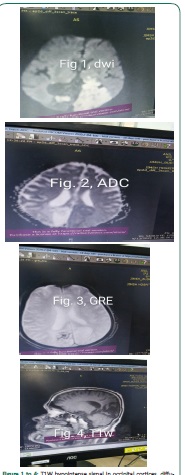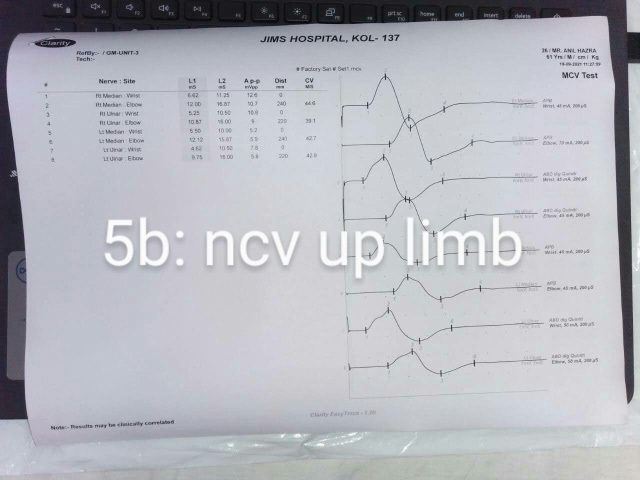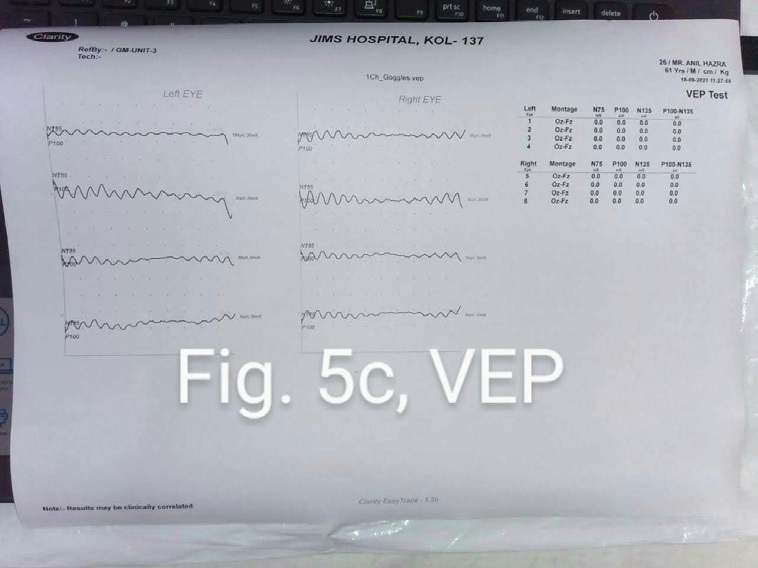
Journal of Clinical Images and Medical Case Reports
ISSN 2766-7820
Case Report - Open Access, Volume 3
Anton syndrome due to bilateral posterior cerebral artery stroke with polyneuropathy in a patient with uncontrolled diabetes mellitus
Subhadeep Basu1; Suprotim Ghosh1; Krishnendu Choudhury2*; Swapan Sarkar3
1 Resident, Jagannath Gupta Institute of Medical Science, Kolkata, India.
2 Assistant Professor and Neurologist, Jagannath Gupta Institute of Medical Science, Kolkata, India.
3 Associate Professor, Department of Medicine and Neurology, Jagannath Gupta Institute of Medical Science, Kolkata. India.
*Corresponding Author: Krishnendu Choudhury
Assistant Professor, Department of Medicine and
Neurology, Jagannath Gupta Institute of Medical
Science, Kolkata, India.
Email: kushal.ch2009@gmail.com
Received : Jan 05, 2022
Accepted : Mar 17, 2022
Published : Mar 24, 2022
Archived : www.jcimcr.org
Copyright : © Choudhury K (2022).
Abstract
Anton syndrome comprises of visual loss from cortical damage with patients not perceiving their own blindness in the absence of psychiatric illness or underlying cognitive impairment. Most commonly it results from bilateral posterior cerebral artery stroke. In 1920, Meyer first reported occipital lobe infarction and postulated compression of branches of the posterior cerebral artery as the causal factor for Anton syndrome. Joseph Babinski (1857-1932) used the term “anosognosia” for the first time, to describe the unawareness of the deficit in patients with hemiplegia. We present an elderly man with uncontrolled diabetes mellitus who was admitted with symptoms of sudden blurring of vision and repeated fall but he denied having visual loss. On evaluation he was found to have bilateral posterior cerebral artery ischemic stroke with hemorrhagic conversion leading to cortical blindness as well as distal demyelinating motor sensory polyneuropathy.
Citation: Basu S, Ghosh S, Choudhury K, Sarkar S. Anton syndrome due to bilateral posterior cerebral artery stroke with polyneuropathy in a patient with uncontrolled diabetes mellitus. J Clin Images Med Case Rep. 2022; 3(3): 1755.
Case report
An elderly man of age 61 years was brought to our hospital by his relatives who declared that the patient was complaining of dizziness for previous 2 days and fell several times while moving in the room colliding with chairs and tables but denied having any impairment of his vision. He was a known diabetic for previous 5 years and took medications irregularly and his blood sugar levels were never normal. He was also detected to have hypertension about 3 years ago and took antihypertensive medicines irregularly. He denied having any serious illness earlier. On physical examination, his body built was average with no obesity or cachexia. Pulse rate was 68/min, regular in rhythm; blood pressure was 176/100 mmHg. His respiration and temperature were normal. There was no edema, jaundice, clubbing or cyanosis. On neurological examination, his higher functions were not significantly altered but his insight of illness was impaired so that he confabulated while asked about his visual impairment. He could not visually recognize any of his relatives. He also could recognize the examining doctor by his conversation. Despite blindness, the patient suffered a visual anosognosia, since he was unaware of his blindness and was confabulating about his surroundings when asked for. His speech was fluent with normal comprehension and repetition. Cranial nerves examination showed absence of visual perceptions with normal pupillary light reaction. No other cranial nerve abnormalities was detected.
Motor system examination revealed decreased power in lower limbs with decreased knee and ankle jerks bilaterally. Babinski sign was present bilaterally. Sensory system examination revealed diminished vibration and position sensation in both lower limbs without any impairment of pain sensation. Cerebellar signs were absent. His gait was high stepping but couldn’t walk without support.
Symptoms localization: Visual loss with normal pupillary reaction: occipital cortex. Stoppage gait with impaired vibration and proprioception: peripheral large fibre neuropathy.
Confabulation: visual anosognosia.
Investigations: Routine complete blood count showed no abnormality. Fasting and post prandial blood sugar levels were 180 mg/dl and 350 mg /dl respectively. Serum cholesterol was 230 mg/dl, LDL 175 mg/dl. Kidney, Liver and Thyroid function tests were normal.
Treatment
The patient was treated with modest doses of antihypertensives with a target blood pressure not falling below 150/85. His diabetes mellitus was initially treated with humanised soluble insulin and then with oral hypoglycemics including gliptin and biguanide combination. Hyperlipidemia was managed with statin and dietary modification. Physiotherapy was instituted and psychological counseling done to improve his insight. After about 10 days, he did not have confabulation and verbally admitted his visual loss.
Discussion
This elderly poorly controlled diabetic and hypertensive patient presented with sudden dizziness and visual loss and anosognosia due to acute ischemic stroke in left visual cortex and small hemorrhage in right occipital cortex. He also had an old infarct with gliosis in right occipital cortex. Absence of visual evoked potential bilaterally confirmed his cortical blindness. Bilateral posterior cerebral artery stroke presenting with visual anosognosia with denial of blindness in this patient was diagnostic of Anton syndrome [1,2]. He also had distal symmetric axonal polyneuropathy in lower limbs with some associated demyelination suggested by NCV study. This is most likely related to his uncontrolled diabetes mellitus for prolonged period [3]. Though diabetes mellitus has been found to be complicated by macrovascular lesions like stroke and microvascular lesions like peripheral neuropathy [3], a combination of both polyneuropathy and cerebral infarcts has not been published in the literature.
Conclusion
Cerebrovascular disease is the most common cause of Anton’s syndrome, and can be a potential complication of uncontrolled diabetes mellitus. Uncontrolled diabetes mellitus is also frequently complicated with cranial as well as peripheral polyneuropathy. Thus, any patient with diabetic cerebrovascular stroke should be evaluated for associated polyneuropathy. Physical therapy and occupational rehabilitation with secondary prevention of stroke are essential part of management of these complications.
References
- Zukic S, Sinanovic O, Smajlovic E et al : Anton’s Syndrome due to Bilateral Ischemic Occipital Lobe Strokes. Case Rep Neurol Med 2014.
- Aldrich M. S., Alessi A. G., Beck R. W., Gilman S. Cortical blindness: etiology, diagnosis, and prognosis. Annals of Neurology. 1987; 21(2): 149-158. doi: 10.1002/ana.410210207.
- Fowler MJ: Microvascular and Macrovascular Complications of Diabetes. Clinical Diabetes 2008; 26(2): 77-82.





